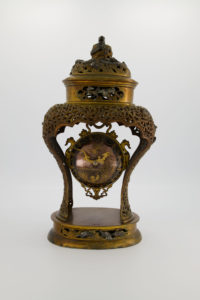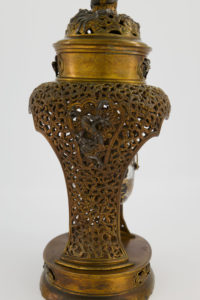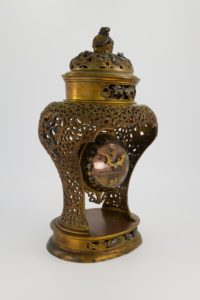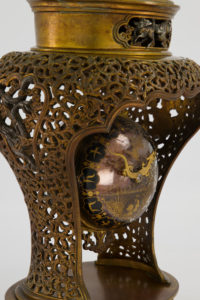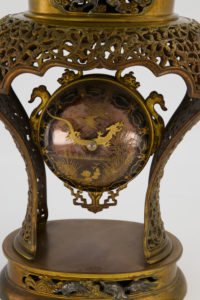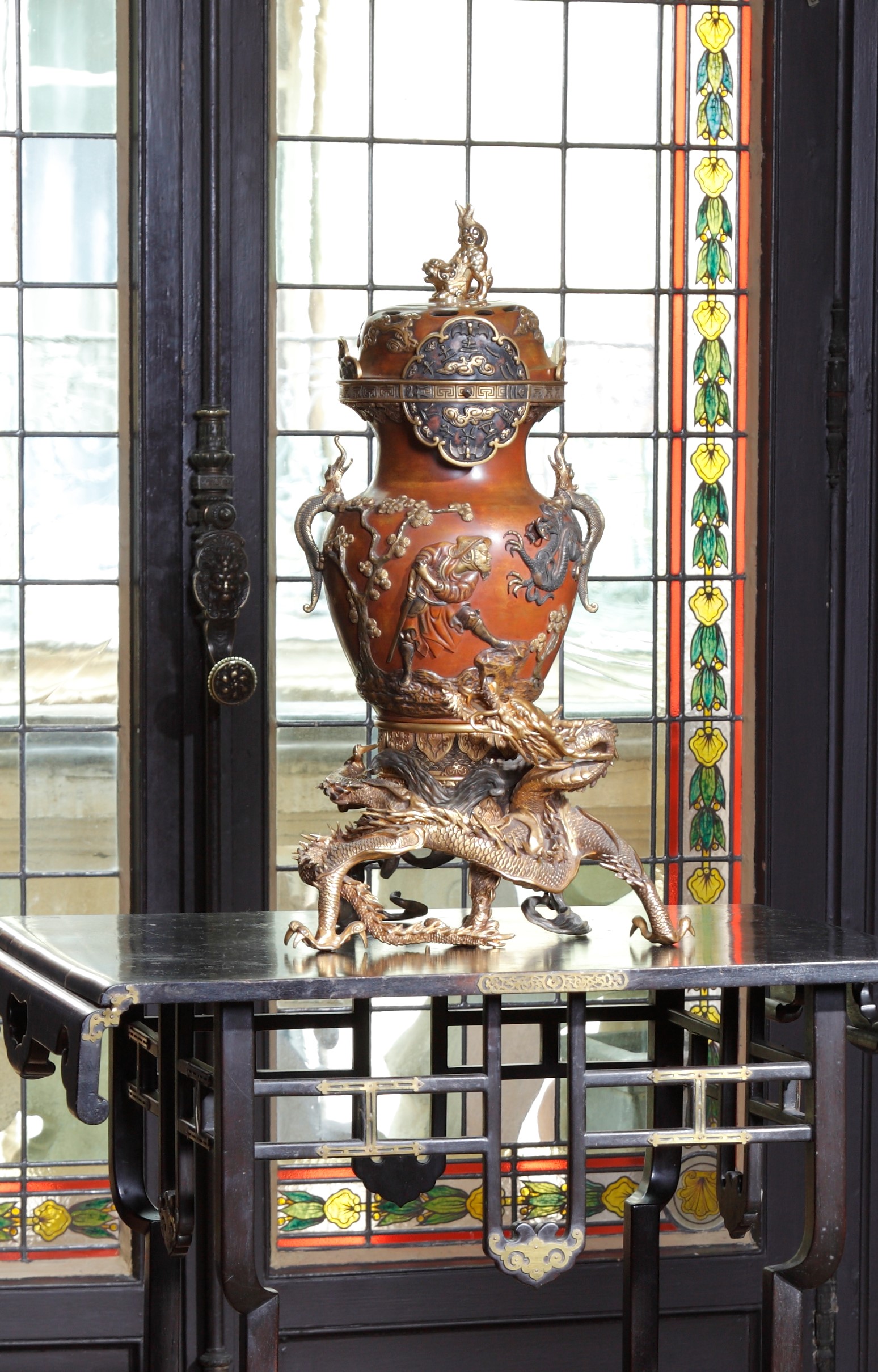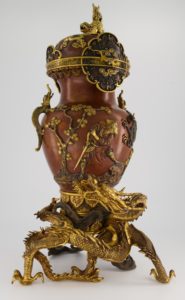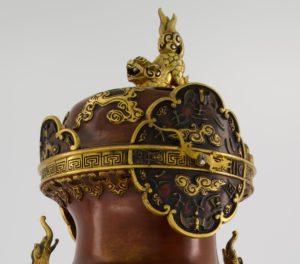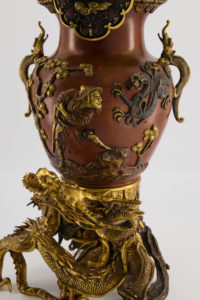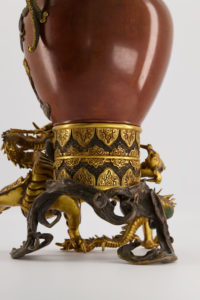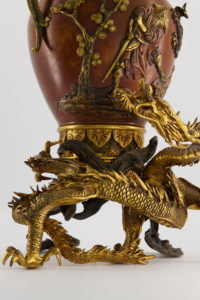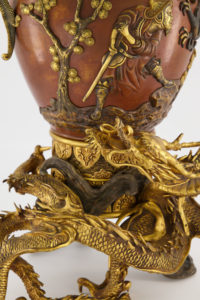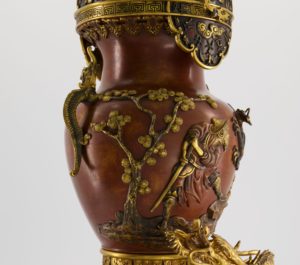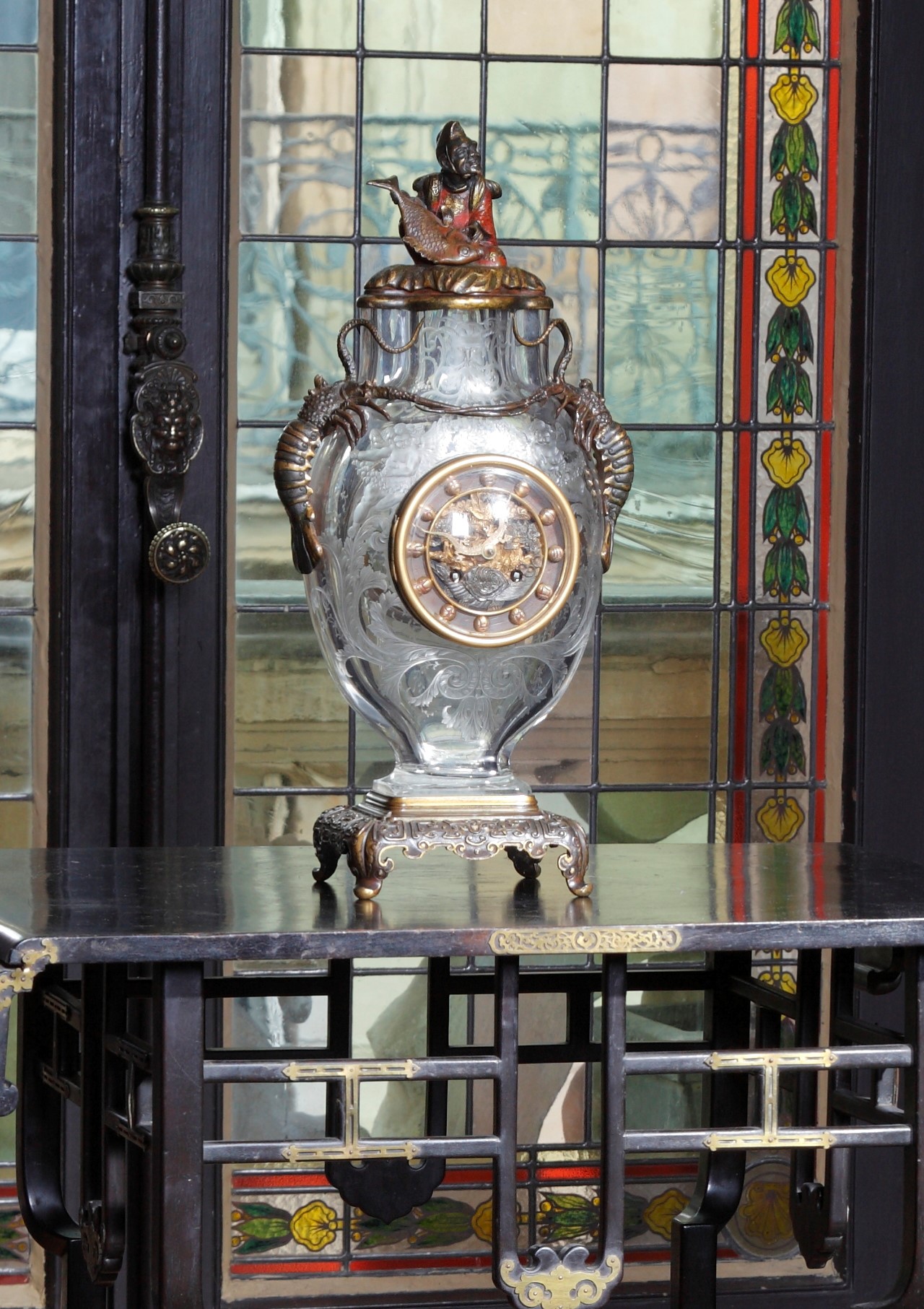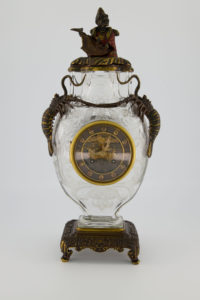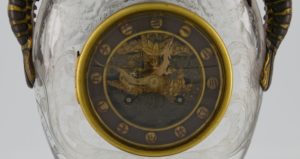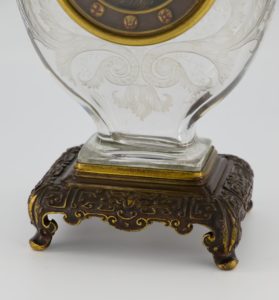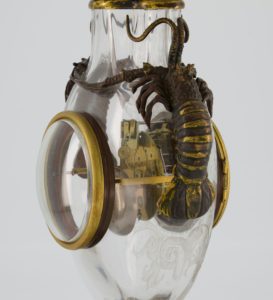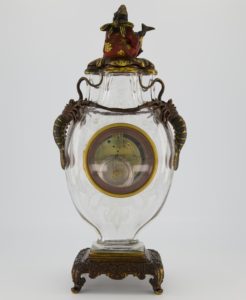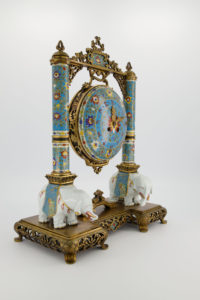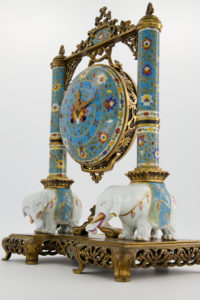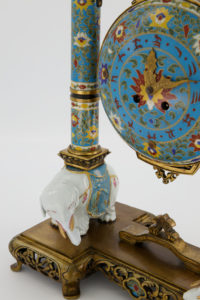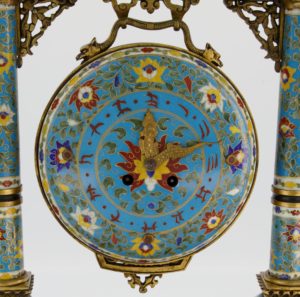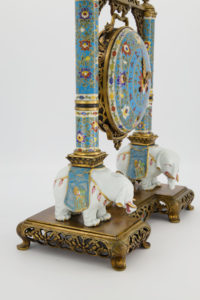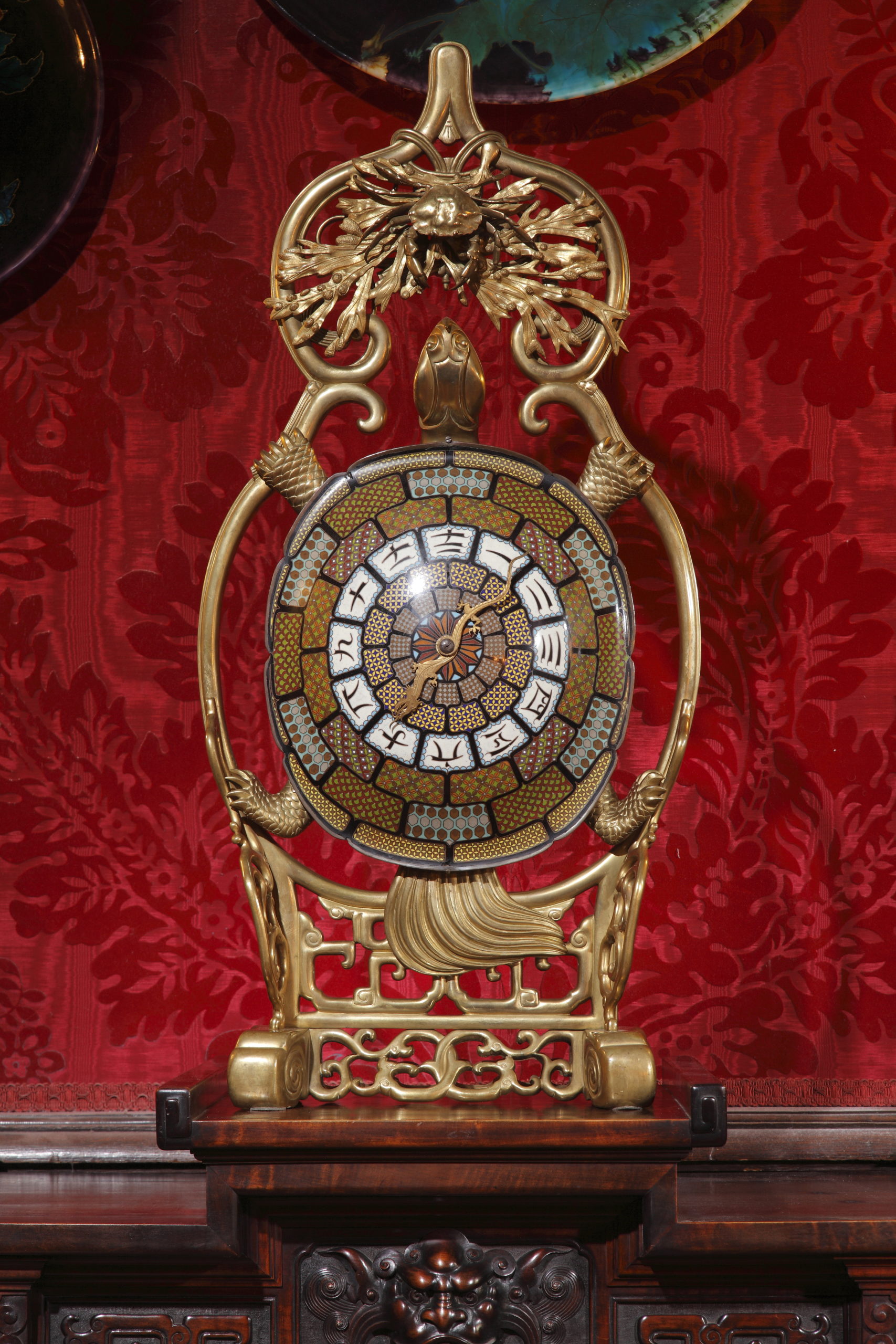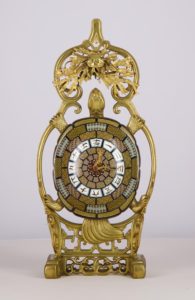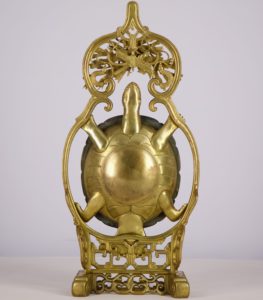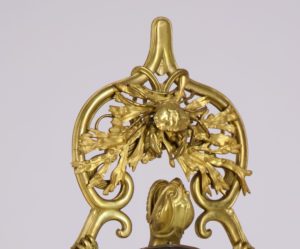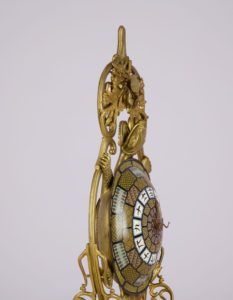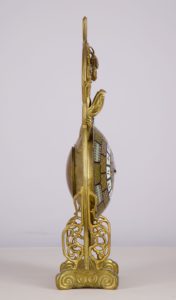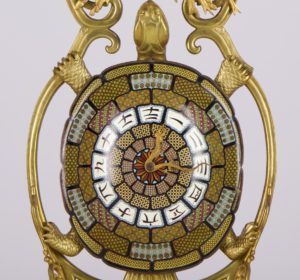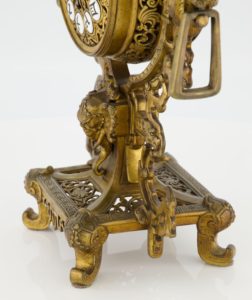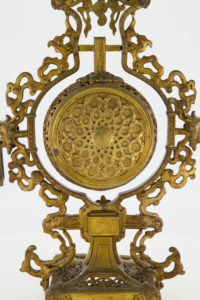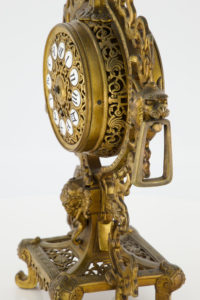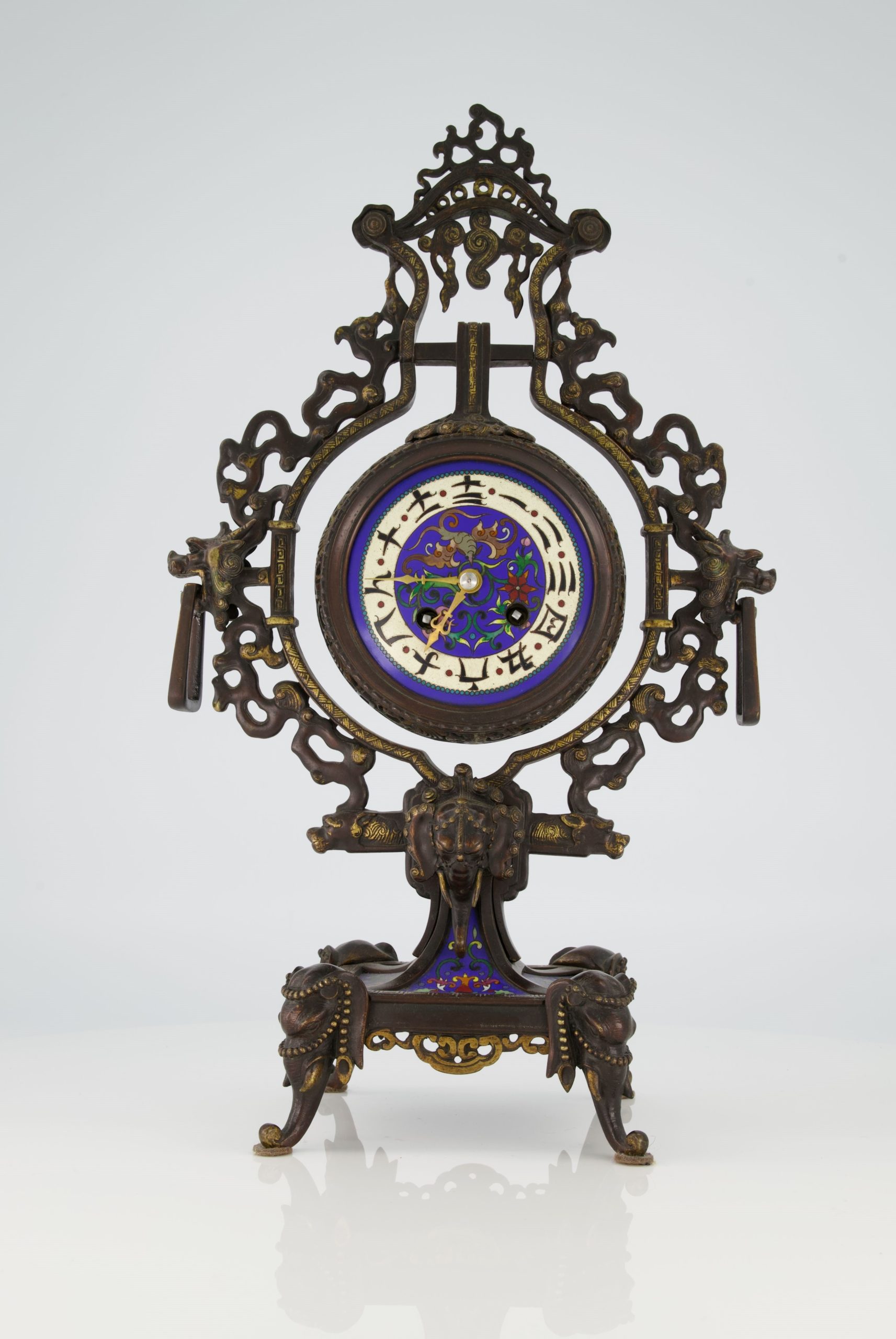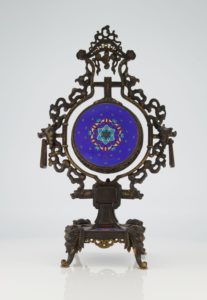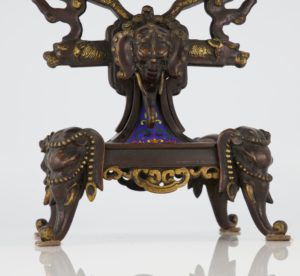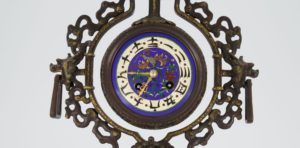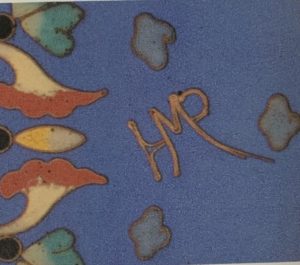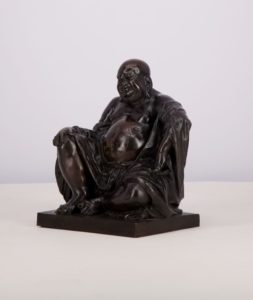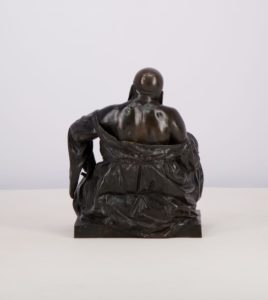We present here our collection of clocks attributed to l’Escalier de Cristal because of their style inspired by the Asian ornamental and architectural vocabulary and thanks to the notebooks of Henry Pannier. We also find on each some common characteristics such as the hands representing a dragon or the movement signed Japy.
Drawing and mention Henry Pannier’s notebook
Materials : bronze and crystal
Provenance : France, after 1885
Dimensions : H :
Breastplate Tam-Tam clock
This breastplate Tam-Tam clock was undoubtedly produced by l’Escalier de Cristal after 1885 since it appears in the notebook of Henry Pannier. It shows the mention of the breastplate Tam-Tam clock with the cloisonné dial accompanied by a drawing and below the mention of its version with the crystal dial as we possess it.
Placed on an oval base decorated with silver-plated bronze turtles, this clock model consists of a beautiful curved frame in gilded bronze openwork with Japanese motifs and decorated with dragons and turtles applied in silver-plated bronze. The frame frames a round crystal dial suspended by a double-headed dragon with a sinuous body, it is decorated with a monochrome decoration borrowed from poetry, representing a Japanese lacustrine landscape, where the golden figures are written in Kanji in cartouches with a black background.

© Annick et Didier Masseau, L’Escalier de Cristal le luxe à Paris, Editions Monelle Hayot, 2021
Pages 13-14 from Henry Pannier’s notebook where is drawn our clock next to the mention « Pendule Tam Tam cuirasse cloisonné » and on the line below : « Pendule Tam Tam cuirasse crystal Br. outside ». We also learn that the model with the crystal dial was made in two copies.
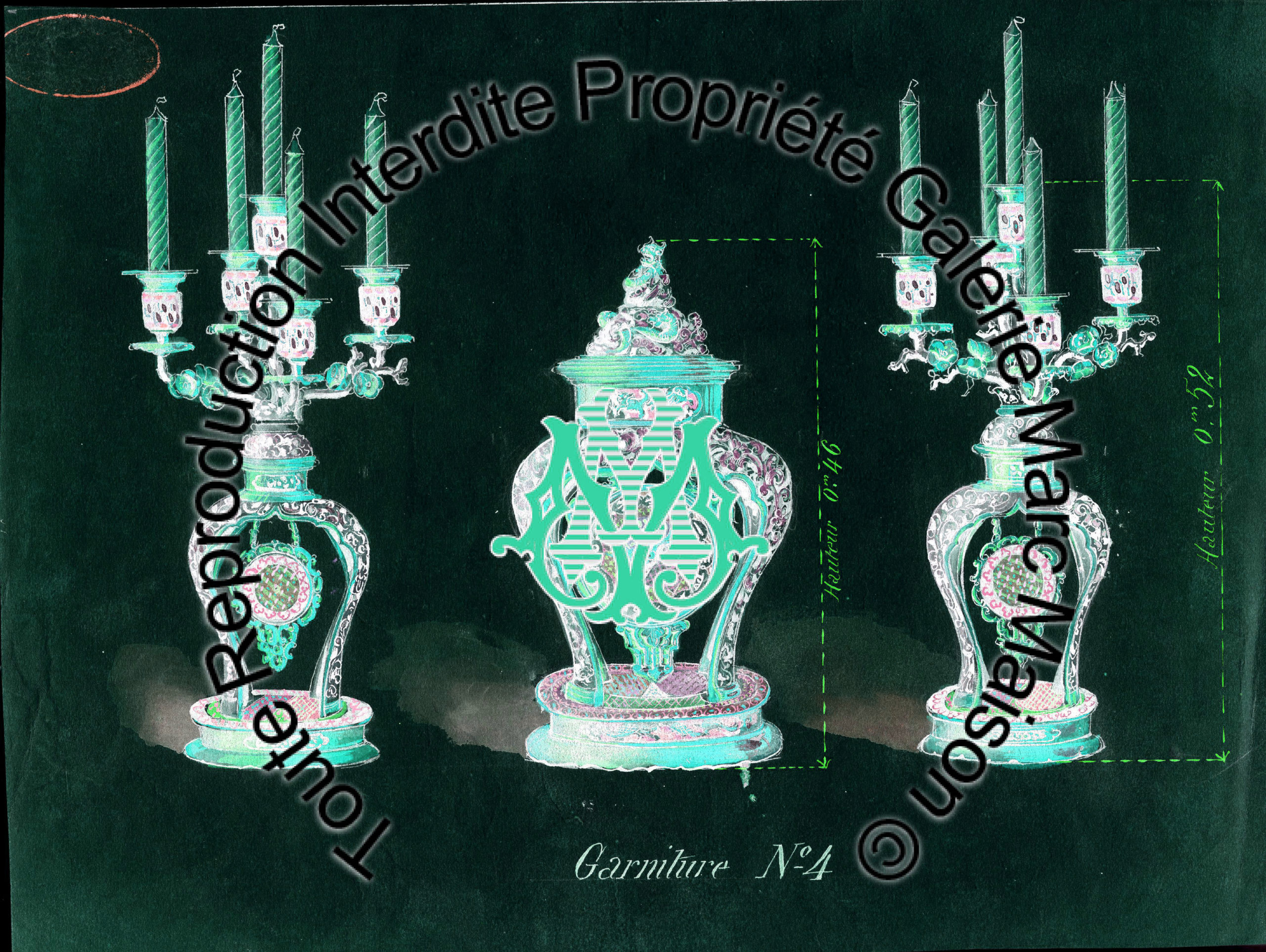
We also find on the archives of the maison Perret & Vibert a clock model with the same shape and the same decorative element. This parallel shows the close connections and the inspiration exchanges between the important houses selling decoratives worksof art in the late 19th century.
The image on the right was probably a drawing made from Henry Pannier’s model, and the image above, a model of garniture sold by the maison Perret & Vibert.
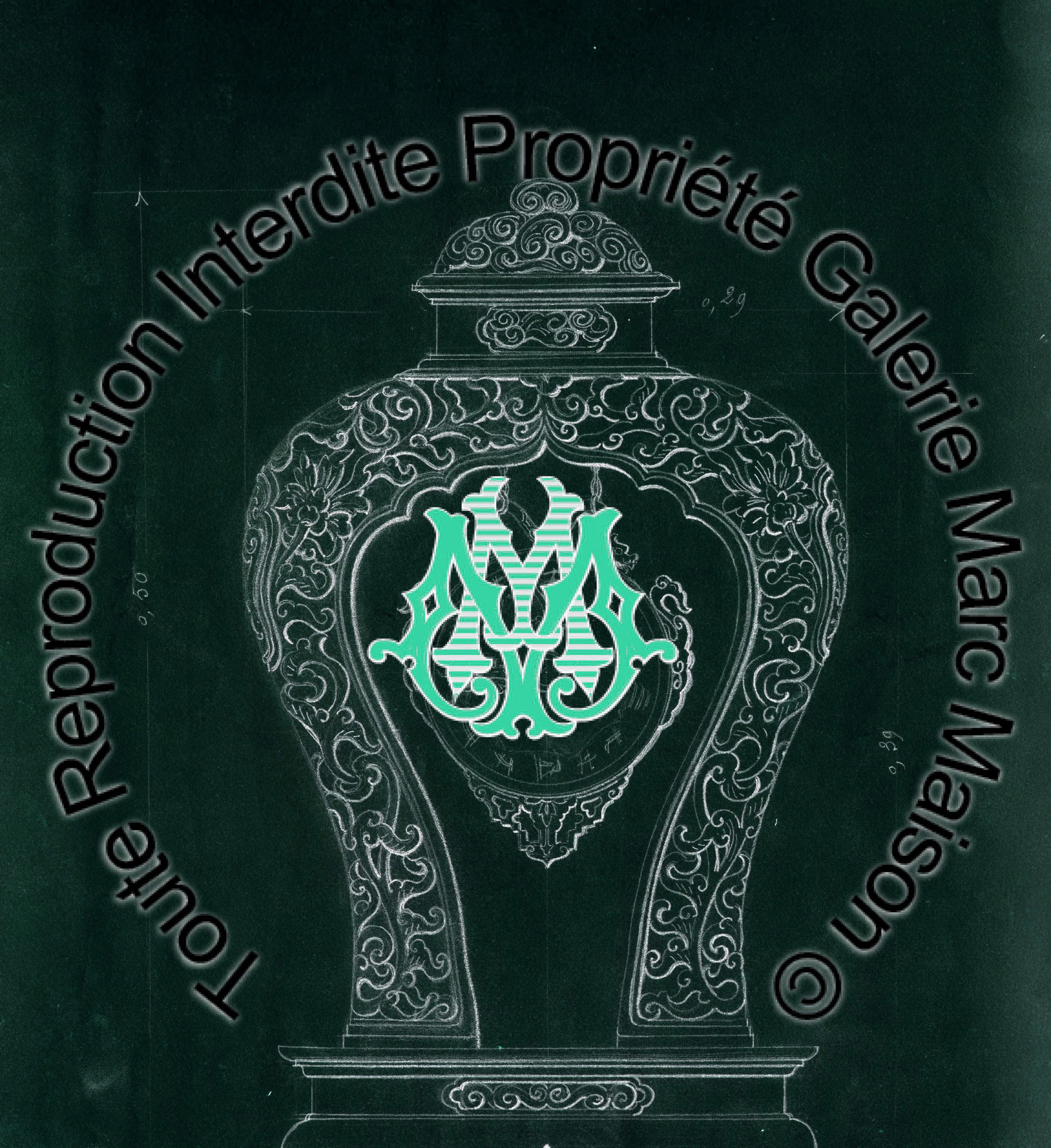
Clock-shaped vase with dragon frame
This bronze clock, of great creativity and quality of workmanship, presents an impressive decoration inspired by Japanese iconography. It appears in one of the notebooks of Henry Pannier under the name «Vase crystal frame dragon forming clock». One can see next to the sketch whose resemblance to our clock is not questionable, that only two copies were sold, one in crystal and the other in bronze.
The poly-lobed dial is placed on the top of the baluster body of the clock taking the form of a patinated bronze potiche and crossed by a frieze, the dial has numerals that stand out in relief in Japanese calligraphy. Just like the hands that have the shape of a dragon whose head indicates the hours and tail the minutes, the entire decor revolves around this same mythical animal. Indeed, the decoration on the belly depicts an Asian warrior raising his sleeve to fight a dragon in a rocky and wooded landscape. The two handles on each side are also shaped like a dragon with a undulating body along the walls of the clock. The quality of execution and carving of the base leaves no doubt about the hand of a bronzer in full mastery of his art. The latter produces here a roaring monster with an intertwined body, marked by a multitude of small scales and resting on its imposing clawed legs.

© Annick et Didier Masseau, L’Escalier de Cristal le luxe à Paris, Editions Monelle Hayot, 2021
Page 39-40 of Henry Pannier’s notebook whre our clock id drawn next to the mention « Vase crystal mount on dragon forming clock (Schlomach ?) ». We notice in the part giving the name of the two buyers, that a model was made of cristal, the other of bronze.
Attributed to l’Escalier de Cristal
Materials : Crystal and polychromatric bronze
Provenance : France, after 1885
Dimensions : H : 46 cm, L : 23cm, P : 12cm
Clock vase with crayfish
This clock reflects the historicist stylistic current of the second half of the nineteenth century by the choice of its form and its decoration which is inspired by the baroque style by associating it with Japonism. Indeed, the body of the clock was made in the shape of a vase with a crystal body cut and mounted in bronze. The crystal-engraved decoration is inspired by European motifs from the previous century. Indeed, there is a decoration all around the dial composed of windings of acanthus leaves surmounted by two angelots and a mascaron of bearded man in a pattern of knotwork.
The decoration of the bronzes is inspired by Japanese iconography. This inspiration can be seen on the chiseled lines in relief that adorn the base in patinated bronze or on the numerals of the dial that use Japanese calligraphy. In addition, on each side of the body of the clock, the creator of this model added bronze studs of a remarkable chisel representing two important crayfish, symbol of gratitude to Japan. Finally, the clock is set with a polychrome bronze figure dressed in a Japanese outfit holding in his hands a carp, an animal emblematic of Japonism
Variant of the Tam-tam clock
This clock in the shape of a Japanese temple composed of a portico holding a suspended dial is a variant of the model appearing in the notebooks of Henry Pannier, under the name «Pendule Tam-Tam».
With a gilt bronze decoration, polychrome enamel imitating cloisonné and ceramic, our clock is placed on an H-shaped base, in bronze decorated on the sides with a decoration of Japanese openwork interlacing. The enamelled decoration of a great refinement represents a multitude of flowers of shimmering colors of oriental inspiration on a blue background. This decoration is found on the columns and pediment, the main face and the back of the dial as well as on the backs of the enamelled ceramic elephants. Their delicate white colour and gold-accented tusks support the portico. The columns bear a bronze pediment with openwork decoration of flowers and shapes inspired by Japanese iconography that supports by two hooks and a double-headed dragon with a wavy body, a round dial that uses the same enamelled decoration as on the columns. The hour figures are written in Japanese.
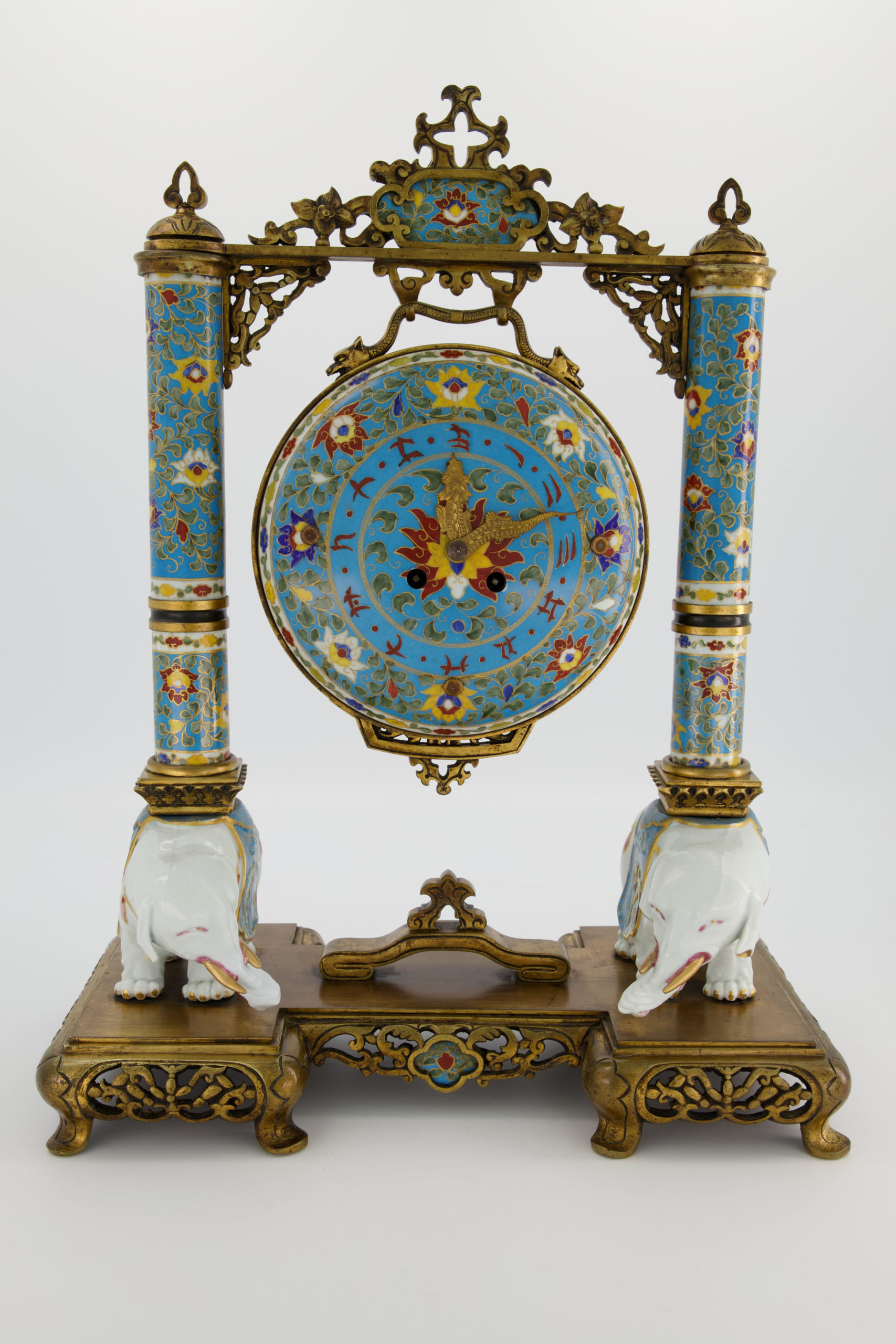
Drawing and mention in Henry Pannier’s notebook
Materials : Bronze and enamelled ceramic
Provenance : France, after 1885
Dimensions : H :
Attributed to l’Escalier de Cristal
Materials : Gitl bronze and enamel
Provenance : France, after 1885
Dimensions : H : 84cm, L : 40 cm, P : 19cm
Turtle and Crab Clock
This exceptional Japanese-inspired gilded bronze clock is representative of the European taste of the second half of the 19th century and the production of l’Escalier de Cristal.
Its originality lies in the choice of the main ornamental subject, the turtle. Indeed, it is the back of the carapace of the animal that serves as a dial and support to the enamelled decoration whose scales are represented by a repetition of coloured motifs of oriental inspiration. It is attached to the portico by the four finely chiseled legs of the animal. The portico rests a square base of sea green marble flanked in the corners by golden bronze elephant heads. It is adorned in its upper part with a crab in a setting of algae that the turtle tries to catch.
The portico system is recurrent in the production of the clocks by l’Escalier de Cristal, we find, moreover, concrete examples illustrated in the notebooks of Henry Pannier.
Clock with openwork decoration
The Kanji numerals of our clock are painted black on porcelain medallions inlaid on the dial. Its round shape is suspended in an openwork decoration made up of multiple curves of Asian inspiration. The structure of the whole, very fine, rests on a platform with four feet.
This clock uses an ornamental vocabulary typical of Asian art carved in a polyvarnish bronze with a great finesse and great attention to detail. Thus, on each side, the openwork curves are extended by two dragon heads, mouth ajar. At the base, an elephant head, looking down, is placed in strong relief. It is surrounded by two dragon heads carved in bronze that echo the sinuous feet.
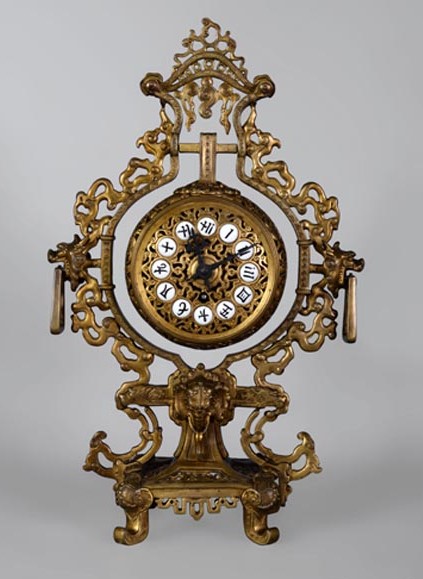
Attributed to l’Escalier de Cristal
Materials : Bronze polyvernished
Provenance : France, after 1885
Dimensions : H : 43 cm ; L : 27 cm ; P. : 14 cm.
Attributed to l’Escalier de Cristal and enamel maker monogram
Material : Gilt bronze doré and enamel
Provenance : France, after 1885
Dimensions : H : 45,5 cm, L : 26 cm, P : 15cm
Clock with openwork and enamelled decoration
Inspired by Japanese iconography like many objects produced by l’Escalier de Cristal, this small bronze clock of a certain quality of realization, rests on four feet representing elephant heads. Its dial is held by a frame that frames it, representing stylized clouds, characteristic of the Japanese iconographic vocabulary. The dial is decorated with delicate polychrome flowers on a dark blue enamel background imitating the cloisonné. This same enamelled decoration, signed with the monogram «HMP», is found on the base, itself decorated with an elephant head in high relief, echoing the four feet.
Buddha clock
The inspiration of this very original clock is undeniable. It takes the form of a Buddha, a major figure in the popular tradition and in many Asian religions. It generally represents generosity, wealth and abundance. More than its original form, the refinement and its high quality of execution are also to be emphasized.

Attributed to l’Escalier de Cristal
Materials : Patinated bronze
Provenance : France, after 1885
Dimensions : H :

